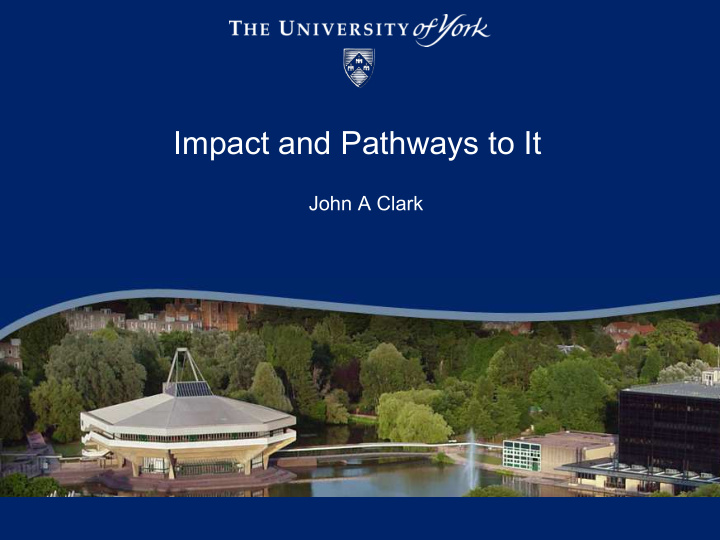



Impact and Pathways to It John A Clark
What is impact Impact is the demonstrable contribution that excellent research makes to society and the economy.
Impact Questions n Need to answer basic questions: n Who benefits? n How will they benefit? n What are you going to do to provide opportunities for benefit to actually occur? n The general idea is that serendipitous take-up of research by non-academics is not an effective means of creating wider societal benefit from research.
Academic Impact Academic beneficiaries may be your immediate n research community (communities) and anyone else in academia/research who may use your research. n This is not the sort of impact we are concerned with here. We are interested in effecting the world outside n academia.
Target Impact Domains
Timescales for Impact 0-5 years 5-10 years 11-20 years 20-50 years Envisaged or potential impact DOES NOT NEED TO BE IMMEDIATE
Who Benefits? n Be as specific as possible about this. Who are the intended or at least clear potential beneficiaries of the research? n The primary intended near term beneficiaries of this work are UK avionics industry developers of advanced full authority digital engine controllers (FADECs), e.g. Rolls Royce Aero-engines (who are a collaborator on this project). n Automotive developers of sophisticated integrated engine management systems may also benefit (e.g. Jaguar) n The down-stream users of systems produced by the above.
How will they benefit? n Be as specific as possible about this. n If successful, the techniques to be developed in this proposal have the potential to reduce development cost by 50% whilst increasing ease and rigorous of verification. n The down-stream buyers/users of any systems developed will benefit from decreased unit costs for engines. n Passengers on civil airlines will ultimately benefit from increased safety.
What are you going to do ? n There are heaps of possible things you can do. Here are just two examples: n Rolls Royce are a collaborator on this FadecRIGHT project and have agreed to trial the project’s developed techniques on an internal research project starting in year 3 of our project. n We intend to propose an IET Colloquium on Engineering High Integrity Engine Controllers to showcase relevant work in this area. This will naturally include our research, but the PIs of other control-oriented complementary EPSRC grants (EP/12345/1, EP/23456/1, EP/34567/1) have expressed their enthusiasm for this. This will attract interest across several domains: EP/12345/1 has Jaguar Landrover as a collaborator, EP/23456/1 has McClaren F1 as a collaborator, and EP/ 34567/1 has Surrey Satellites as a collaborator. So we aim to cover aerospace, consumer automotive, Formula 1,and space control.
Examples of Costed Impact Activities n Extra time allocated to impact activities n Public engagement n Training (e.g. in communication with non-academic audiences) n Relevant colloquia, workshops etc. n Either existing n New ones to be initiated by you n Local special interest groups or industrial collaborators. n For very large projects it may be an idea to factor in some element of market analysis and the like.
Examples of Costed Impact Activities n Things not fundable by EPSRC: n various IPR-related instruments, e.g. patents fees
Miscellaneous n Some research is easier to package for particular audiences than others: n Swarm robotics with toy helicopters is likely more “demonstrable” to school children than novel approaches to the definition of semantics for programming languages. n This sort of observation is accepted. n Important thing is to identify your targets and then seek to give them the opportunity to benefit. n If, for example, public engagement doesn’t seem the right thing to do, then don’t do it. n Important to distinguish what will occur within the lifetime of the project and hence is fundable by the EPSRC and aspirations or planned activities thereafter.
Impact Track Record n Need also to get across your track record (if you have it) in impact activities: n Successful collaborations with stakeholders (e.g. industrial collaborators) n Public engagement activities you have done. n Industrial experience. You can use this to indicate the range of systems you have worked on with characteristics that are relevant to your proposed work.
Impact Track Record n Contd: n Experience of organising colloquia on commercially relevant topics. n Engagement in UK and international standards activities n Setting up of any spin-offs – it doesn’t have to be in the direct area of your proposal, you are showing that you have the experience of setting up a spin-off (a non-trivial undertaking and you have traversed the learning curve already). n How your research has fed into externally focused CPD courses.
Recommend
More recommend